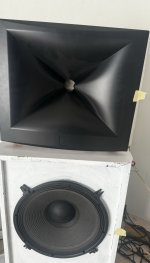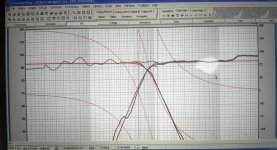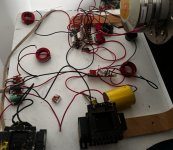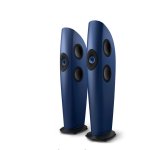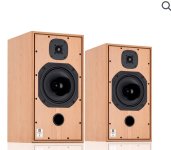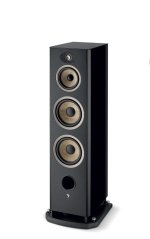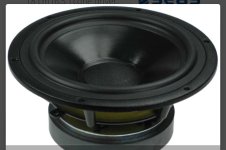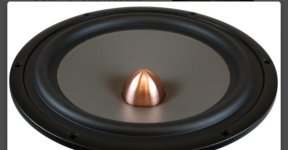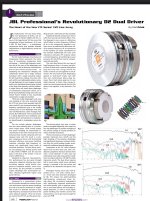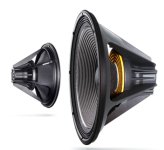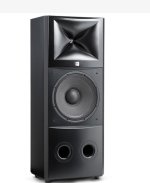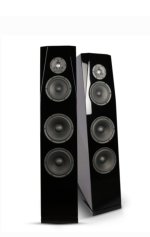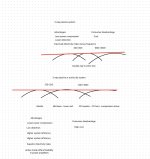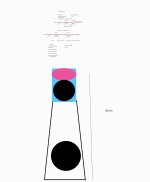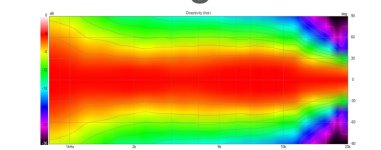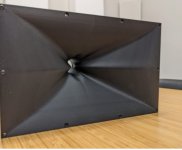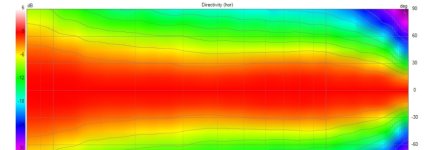macka: thanks for the advice. As a lifelong musician and studio person I go with what works. The Alephs (Thatcher's design) are so much better than any other amp I have used I have built 4 sets and will use them going forward. They are plenty dynamic enough with high efficiency speakers. If you are referring to Class D amps with your suggestion of high-speed fets, I will pass. Have tried them and find them to be sterile.
Eric was supportive of the Aleph/Ulfbehrt combination but communcation stopped after our initial conversation. Don't know why. Am only in my summer residence for another 2 months and, so, cannot wait longer for speaker delivery.
Have found that the speaker market is so elevated that a $10k price point is on the low rather than middle ground. A good eample is the JBL Project Everst DD67000. This horn speaker has a lot of attributes I would like to hear but is priced at $93,500. Cannot justify this amount for the materials and engineering involved.
Eric was supportive of the Aleph/Ulfbehrt combination but communcation stopped after our initial conversation. Don't know why. Am only in my summer residence for another 2 months and, so, cannot wait longer for speaker delivery.
Have found that the speaker market is so elevated that a $10k price point is on the low rather than middle ground. A good eample is the JBL Project Everst DD67000. This horn speaker has a lot of attributes I would like to hear but is priced at $93,500. Cannot justify this amount for the materials and engineering involved.
You keep making assertions without any backup. Plus, your attempts to be clever and cute instead are getting tiresome and boring. So, I see no point in continuing this back and forth.Well your answer is in your own response.
Last edited:
Hi Crag159,
I agree on the pricing. Post Covid everything went north unfortunately. If you are interested the JBL S9900 or the 4367 are top notch. If you pop over the the Lansing Heritage Forums there is a lot of folks there with hands on experience. If you can find an Array 1400 it won’t disappear in the soundstage and imaging stakes.
Good luck with your search
I agree on the pricing. Post Covid everything went north unfortunately. If you are interested the JBL S9900 or the 4367 are top notch. If you pop over the the Lansing Heritage Forums there is a lot of folks there with hands on experience. If you can find an Array 1400 it won’t disappear in the soundstage and imaging stakes.
Good luck with your search
I lot of members have made some constructive contributions to this thread.
I recently suggested that a diy loudspeaker be collaboratively designed that would be better than an equivalent consumer loudspeaker. No takers on the effort yet.
There simply are to many variables and considerations to make a definitive judgement yes or no on the original post in this thread.
What we do know is the raw hifi drivers have unfortunately become more expensive particularly the high performance variants.
This logically puts more pressure on the diy design to come up with system with high value drivers that punches above it’s weight.
That avenue in my opinion leads to a pre determined diy design provided my a driver manufacturer or a diy outlet such as MadiSound etc. The point being if you are only interested in doing a diy loudspeaker once then a pre determined kit with credentials and buyer reviews is a low risk option. There is still plenty to enjoy and have fun with assembling a kit. A pre determined design is proof of what it will do in advance of spending your money.
Upping the stakes the Elsinore diy loudspeaker is a well respected system with some driver variations.
https://www.diyaudio.com/community/threads/the-elsinore-project-thread.97043/page-303#post-7752894
The common thread with the above is that they all answer the first question before you start on your diy journey. What is it than l am going to design and build?
In my opinion this is the most overlooked step and has been discussed in a number of posts in this thread. We are all human and by our very nature we tend to jump straight in with excitement before thinking through the “what”.
Within the what is the challenge of coming up with something that not only sounds good but is also aesthetically pleasing for the WAF. Not to be taken lightly.
Once worked out you have thoughtfully figured out your options. You might have opted for a single frame full range driver like a Fostex or if you wallet is deep enough a GPA604 with the crossover network provided. This choice leaves you to build the enclosure.
https://greatplainsacoustics.com/collections/frontpage
Another option is to clone a consumer loudspeaker and attempt to make it better. The advantage here is the diy build can make a more solid enclosure and use high quality crossover parts.
This post isn’t a complete summary but l think help wrap up what is a very interesting thread.
I recently suggested that a diy loudspeaker be collaboratively designed that would be better than an equivalent consumer loudspeaker. No takers on the effort yet.
There simply are to many variables and considerations to make a definitive judgement yes or no on the original post in this thread.
What we do know is the raw hifi drivers have unfortunately become more expensive particularly the high performance variants.
This logically puts more pressure on the diy design to come up with system with high value drivers that punches above it’s weight.
That avenue in my opinion leads to a pre determined diy design provided my a driver manufacturer or a diy outlet such as MadiSound etc. The point being if you are only interested in doing a diy loudspeaker once then a pre determined kit with credentials and buyer reviews is a low risk option. There is still plenty to enjoy and have fun with assembling a kit. A pre determined design is proof of what it will do in advance of spending your money.
Upping the stakes the Elsinore diy loudspeaker is a well respected system with some driver variations.
https://www.diyaudio.com/community/threads/the-elsinore-project-thread.97043/page-303#post-7752894
The common thread with the above is that they all answer the first question before you start on your diy journey. What is it than l am going to design and build?
In my opinion this is the most overlooked step and has been discussed in a number of posts in this thread. We are all human and by our very nature we tend to jump straight in with excitement before thinking through the “what”.
Within the what is the challenge of coming up with something that not only sounds good but is also aesthetically pleasing for the WAF. Not to be taken lightly.
Once worked out you have thoughtfully figured out your options. You might have opted for a single frame full range driver like a Fostex or if you wallet is deep enough a GPA604 with the crossover network provided. This choice leaves you to build the enclosure.
https://greatplainsacoustics.com/collections/frontpage
Another option is to clone a consumer loudspeaker and attempt to make it better. The advantage here is the diy build can make a more solid enclosure and use high quality crossover parts.
This post isn’t a complete summary but l think help wrap up what is a very interesting thread.
macka: Went to this site and it is of limited value because the search engine required registration and "Sorry, registration has been disabled by the administrator." Difficult to acquire information but thanks anyway for the reference.If you pop over the the Lansing Heritage Forums there is a lot of folks there with hands on experience.
macka: Went to this site and it is of limited value because the search engine required registration and "Sorry, registration has been disabled by the administrator." Difficult to acquire information but thanks anyway for the reference.
Did you look here? Not the forum but some info is accessible. What were you looking for?
Rob 🙂
https://www.lansingheritage.org/html/jbl/jbl.htm
Hi Craig,
Another possibility is the M2 /D2 horn and driver combo with a 2216nd 15 inch woofer.
If you can get a wood shop to cut the mdf sheet to size for 5 cu ft 3 bass reflex enclosure you have access to essentially a state of art diy system.
* A number of M2 diy monitor clones have been built by diy addicts over the past 8 years using various dsp crossover set ups and with various jbl conventional compression drivers. The exact dsp crossover and EQ specified by JBL is normally only available for use in noisy Crown pro amps or a BSS London Sound dsp network which can also be prone to fan noise. This spoils other otherwise excellent performance of these transducers in a residential domestic living room.
The dsp approach has also proven a time consuming and arduous task to get right for those you aren’t versed in setting up complex pro processors.
To date don’t believe a passive version with the original 6th order crossover and a passive EQ characteristics has been attempted. I have therefore been trialling a passive 6th order 2 way network with passive EQ that l designed with Linear X Leap 5 recently. The low frequency electrical assisted EQ used in JBL M2 monitor isn’t absolutely necessary for consumer hifi use.
See the attached a a pic of the test rig using low cost parts from my parts bin and the indoor driver measurements with the Leap 5 simulation.
Rob has previously built a passive network for his 0476 Mg drivers using the M2 horn and the 2216nd sometime ago.
I think we are in agreement that it’s a very impressive set up.
These systems are in the order of 93 db / 1 watt. Your Aleph would sound wonderful. For the more adventurous a Diyaudio 6/24 active crossover could be deployed.
Performance.
There are numerous reviews of the JBL M2 monitors. I would suggest that for a much easier implementation a passive network does not give too much away.
If there is a single horn and driver combo that covers from 750-20,000 perfectly this it it. What is does is it translates the harmonic overtones and dynamic contrasts of a recording beautifully without introducing any colouration or artefacts. It doesn’t have a sound. What it does do is cast a pin sharp sound stage with a broad sweet spot.
For around US$2300 in components for a stereo pair it’s a high value diy project compared to the MRRP US$280000 of the M2 pro monitors including Crown power amps to make it work. A passive system doesn’t require that palarver of cables and programming a dsp crossover.
The above defies what a diy loudspeaker builder can achieve without a lot complexity, over thinking , worrying or sleepless nights. You turn it on. It goes and it puts a big smile on your face.
Another possibility is the M2 /D2 horn and driver combo with a 2216nd 15 inch woofer.
If you can get a wood shop to cut the mdf sheet to size for 5 cu ft 3 bass reflex enclosure you have access to essentially a state of art diy system.
* A number of M2 diy monitor clones have been built by diy addicts over the past 8 years using various dsp crossover set ups and with various jbl conventional compression drivers. The exact dsp crossover and EQ specified by JBL is normally only available for use in noisy Crown pro amps or a BSS London Sound dsp network which can also be prone to fan noise. This spoils other otherwise excellent performance of these transducers in a residential domestic living room.
The dsp approach has also proven a time consuming and arduous task to get right for those you aren’t versed in setting up complex pro processors.
To date don’t believe a passive version with the original 6th order crossover and a passive EQ characteristics has been attempted. I have therefore been trialling a passive 6th order 2 way network with passive EQ that l designed with Linear X Leap 5 recently. The low frequency electrical assisted EQ used in JBL M2 monitor isn’t absolutely necessary for consumer hifi use.
See the attached a a pic of the test rig using low cost parts from my parts bin and the indoor driver measurements with the Leap 5 simulation.
Rob has previously built a passive network for his 0476 Mg drivers using the M2 horn and the 2216nd sometime ago.
I think we are in agreement that it’s a very impressive set up.
These systems are in the order of 93 db / 1 watt. Your Aleph would sound wonderful. For the more adventurous a Diyaudio 6/24 active crossover could be deployed.
Performance.
There are numerous reviews of the JBL M2 monitors. I would suggest that for a much easier implementation a passive network does not give too much away.
If there is a single horn and driver combo that covers from 750-20,000 perfectly this it it. What is does is it translates the harmonic overtones and dynamic contrasts of a recording beautifully without introducing any colouration or artefacts. It doesn’t have a sound. What it does do is cast a pin sharp sound stage with a broad sweet spot.
For around US$2300 in components for a stereo pair it’s a high value diy project compared to the MRRP US$280000 of the M2 pro monitors including Crown power amps to make it work. A passive system doesn’t require that palarver of cables and programming a dsp crossover.
The above defies what a diy loudspeaker builder can achieve without a lot complexity, over thinking , worrying or sleepless nights. You turn it on. It goes and it puts a big smile on your face.
Attachments
Last edited:
My colleague and I have delivered quite some DIY subwoofer towers for Norwegian audio enthusiasts. One example is web- magazine “Stereo-pluss” reference subwoofer towers (check youtube). One of the primary benefits of building your own subwoofer tower is the potential for significant cost savings. Commercial subwoofers, especially high-quality models, often come with hefty price tags. Additionally, the cost of shipping these bulky and heavy items can be prohibitively expensive, particularly if you live in a remote area or outside of major markets. By building your own, you can avoid these high shipping costs and allocate your budget more effectively towards better components or materials.
DIY subwoofer towers offer unparalleled flexibility and customization options. When you build your own, you have complete control over every aspect of the design, from the size and shape of the enclosure to the choice of drivers, amplifiers, and digital signal processors (DSPs). This level of customization allows you to tailor the subwoofer to your specific room acoustics, personal preferences, and overall system setup. Commercial subwoofers, on the other hand, are often designed with broad market appeal in mind, which can result in compromises in design and performance.
A common issue with commercial subwoofers is their tendency to be large, bulky, and not particularly aesthetically pleasing ($-issue.) , which can be a point of contention with partners (or spouses) who may not want such an obtrusive device in the living room. By opting for a DIY solution, you can design a subwoofer tower that integrates seamlessly with your existing decor, using materials and finishes that match your style. This way, you can achieve high-performance audio without sacrificing the aesthetics of your living space.
The market for high-end subwoofers is relatively niche (how many are crazy enough), which means that the selection of commercial models can be limited, especially if you are looking for something specific in terms of size, power, or performance characteristics. DIY enthusiasts have access to a vast array of components, allowing them to build subwoofers that meet or exceed the performance of commercial models, even if those models aren’t readily available in their region.
When you build your own subwoofer, you also have the freedom to choose your own amplification and DSP solutions (MiniDSP, Driverack, Trinnov and others) . This flexibility means you can opt for higher-quality, more powerful, or more feature-rich electronics than what might be included in a commercial subwoofer. Moreover, you can upgrade these components over time as technology advances or as your needs change, which is often not possible with a commercial, all-in-one subwoofer unit.
DIY subwoofer towers offer unparalleled flexibility and customization options. When you build your own, you have complete control over every aspect of the design, from the size and shape of the enclosure to the choice of drivers, amplifiers, and digital signal processors (DSPs). This level of customization allows you to tailor the subwoofer to your specific room acoustics, personal preferences, and overall system setup. Commercial subwoofers, on the other hand, are often designed with broad market appeal in mind, which can result in compromises in design and performance.
A common issue with commercial subwoofers is their tendency to be large, bulky, and not particularly aesthetically pleasing ($-issue.) , which can be a point of contention with partners (or spouses) who may not want such an obtrusive device in the living room. By opting for a DIY solution, you can design a subwoofer tower that integrates seamlessly with your existing decor, using materials and finishes that match your style. This way, you can achieve high-performance audio without sacrificing the aesthetics of your living space.
The market for high-end subwoofers is relatively niche (how many are crazy enough), which means that the selection of commercial models can be limited, especially if you are looking for something specific in terms of size, power, or performance characteristics. DIY enthusiasts have access to a vast array of components, allowing them to build subwoofers that meet or exceed the performance of commercial models, even if those models aren’t readily available in their region.
When you build your own subwoofer, you also have the freedom to choose your own amplification and DSP solutions (MiniDSP, Driverack, Trinnov and others) . This flexibility means you can opt for higher-quality, more powerful, or more feature-rich electronics than what might be included in a commercial subwoofer. Moreover, you can upgrade these components over time as technology advances or as your needs change, which is often not possible with a commercial, all-in-one subwoofer unit.
LX 2.5-way pictures posted to fullrange photo gallery:LS50 Meta 1793.... Rather than going to bed I changed LPF to 3rd-order (0.46mH/6.8uF-0.28mH) and raised the HPF frequency to 6khz (SilverZ 1.5uF/0.47mH); tone-sweep-by-ear essentially flat 500hz to ~10khz. Music much more realistic. Imaging seems better too though I haven't done the phase alignment test (2.7-6khz?).
https://www.diyaudio.com/community/threads/full-range-speaker-photo-gallery.65061/post-7769008
How good are our DIY units compared to off the shelf stuff?
Post 304 outlined the benefits of opting for a pre determined diy loudspeaker design (multi way), a single full range driver design or cloning and existing consumer loudspeaker.
The advantage with these options is that you know at the outset “what” it is you’re going to build and what it will do? You also know that it works, it’s been tested and it’s likely been reviewed. This closes the loop on the above question.
In layman’s terms it’s easy to assume that by using best in class or expensive hifi drivers that the diy build is going to be better than an equivalent consumer version. Or the diy enclosure might be better. But is this actually the case? Is there a ceiling upon what a given design can achieve in terms of objective and subjective performance?
Are we splitting hairs like a long winded Stereophile or Absolute Sound Review?
In my opinion there are limits and there are diminishing returns. We are also competing with the laws of physics which mother nature isn’t going to let us break.
Post 304 outlined the benefits of opting for a pre determined diy loudspeaker design (multi way), a single full range driver design or cloning and existing consumer loudspeaker.
The advantage with these options is that you know at the outset “what” it is you’re going to build and what it will do? You also know that it works, it’s been tested and it’s likely been reviewed. This closes the loop on the above question.
In layman’s terms it’s easy to assume that by using best in class or expensive hifi drivers that the diy build is going to be better than an equivalent consumer version. Or the diy enclosure might be better. But is this actually the case? Is there a ceiling upon what a given design can achieve in terms of objective and subjective performance?
Are we splitting hairs like a long winded Stereophile or Absolute Sound Review?
In my opinion there are limits and there are diminishing returns. We are also competing with the laws of physics which mother nature isn’t going to let us break.
Attachments
Last edited:
This brings us to the endless debate of what makes a better loudspeaker? If we were to all to agree it might be bigger and more expensive to build than we care to consider.
The M2 diy clone comes to mind. It seemingly breaks free of the limitations placed on most hifi loudspeakers. It trades the tonal flavours of competing lower efficiency hifi drivers using Magnesium, Nextal, Graphene, Metamodal TPCD, carbon fibre or paper pulp cones for perfectly reproduced harmonic overtones and true realism in dynamic contrasts.
The compromise is size and cost. We then consider alternatives we can afford and live with.
The diy builder can opt for his own original HiFi loudspeaker design or what he believes is going to be better than an equivalent consumer loudspeaker. But, as outlined in a number of posts this assumes a lot of caveats or hurdles in favour of a diy loudspeaker builder versus the consumer manufactured loudspeaker.
Then there are the challenges of determining if the diy loudspeaker is superior to a consumer model? Should this be an objective determination or a subjective determination or both?
Given the disparity between what consumers believe subjectively about an individual consumer loudspeakers we may never definitively come up with a yes or a no answer.
The M2 diy clone comes to mind. It seemingly breaks free of the limitations placed on most hifi loudspeakers. It trades the tonal flavours of competing lower efficiency hifi drivers using Magnesium, Nextal, Graphene, Metamodal TPCD, carbon fibre or paper pulp cones for perfectly reproduced harmonic overtones and true realism in dynamic contrasts.
The compromise is size and cost. We then consider alternatives we can afford and live with.
The diy builder can opt for his own original HiFi loudspeaker design or what he believes is going to be better than an equivalent consumer loudspeaker. But, as outlined in a number of posts this assumes a lot of caveats or hurdles in favour of a diy loudspeaker builder versus the consumer manufactured loudspeaker.
Then there are the challenges of determining if the diy loudspeaker is superior to a consumer model? Should this be an objective determination or a subjective determination or both?
Given the disparity between what consumers believe subjectively about an individual consumer loudspeakers we may never definitively come up with a yes or a no answer.
Attachments
Last edited:
I started DIY a year into the pandemic to help distract the mind. My first DIY trounced all my prior "commercial" speakers except Axiom80. In 3.5 years I've "done" dozens of speaker-experiments each to the point I got my questions answered. I see no limits, and the diminishing returns only in terms of pricy drivers disappoint (always) and not sound quality outcome using frugal parts.In my opinion there are limits and there are diminishing returns.
That maybe so in your situation.
How did you compare them to your speakers?
What were your questions?
To clarify for any given size bookshelf or floor standing Hi-Fi loudspeaker when you compare apples for applies in terms of a specific design (number of drivers, size of drivers, size of enclosure) where did you find the differences?
How did you compare them to your speakers?
What were your questions?
To clarify for any given size bookshelf or floor standing Hi-Fi loudspeaker when you compare apples for applies in terms of a specific design (number of drivers, size of drivers, size of enclosure) where did you find the differences?
The challenge to my mind is coming up with diy focused design that is going to leverage a distinct advantage over a consumer system at a significantly lower cost.
If we look at the objective criteria let’s put together a simple but achievable concept to flesh out. :
Objective Criteria
Lower power compression
Lower distortion
Improved directivity index versus frequency (include diffraction)
Higher efficiency (improved dynamic contrast)
There are a number of ways to achieve this. To keep simple for a diy implement l have illustrated two scenarios in the graphic attached. I have chosen a two way design template because l feel there are too many constraints in a two way system with the commercial consumer market is saturated with.
The trick is to balance the trade offs do as not to not impact on the benefits.
The primary trade off is complexity and picking benign crossover points. This however can be dealt with using a simple but elegant design.
Key design features
Placement of the woofer crossover at 150-200 hertz allows a more focused execution of the woofer driver and enclosure loading.
This frequency placement ensures the whole mid bass - lower midrange is handled by a single driver optimised for this pass band.
The use of a wave guide with a tweeter at an optimal crossover frequency ensures a smooth directivity index. Alternatively a specifically designed wave guide and a compression driver where higher system efficiency is desired.
This design can be scaled from compact to large depending on space and the budget.
It’s particularly well suited to a diy implementation because it leverages the advantages of low compromise objective design choices that would be expensive in a consumer offering.
The nearest thing to the above is the JBL 708 (without a sub)
https://jblpro.com/en/products/708p
MRRP US$1,999 each
If we look at the objective criteria let’s put together a simple but achievable concept to flesh out. :
Objective Criteria
Lower power compression
Lower distortion
Improved directivity index versus frequency (include diffraction)
Higher efficiency (improved dynamic contrast)
There are a number of ways to achieve this. To keep simple for a diy implement l have illustrated two scenarios in the graphic attached. I have chosen a two way design template because l feel there are too many constraints in a two way system with the commercial consumer market is saturated with.
The trick is to balance the trade offs do as not to not impact on the benefits.
The primary trade off is complexity and picking benign crossover points. This however can be dealt with using a simple but elegant design.
Key design features
Placement of the woofer crossover at 150-200 hertz allows a more focused execution of the woofer driver and enclosure loading.
This frequency placement ensures the whole mid bass - lower midrange is handled by a single driver optimised for this pass band.
The use of a wave guide with a tweeter at an optimal crossover frequency ensures a smooth directivity index. Alternatively a specifically designed wave guide and a compression driver where higher system efficiency is desired.
This design can be scaled from compact to large depending on space and the budget.
It’s particularly well suited to a diy implementation because it leverages the advantages of low compromise objective design choices that would be expensive in a consumer offering.
The nearest thing to the above is the JBL 708 (without a sub)
https://jblpro.com/en/products/708p
MRRP US$1,999 each
Attachments
Last edited:
(Short reply before a busy day.)
If you mean where I found differences comparing "apples-to-apples" same acoustic box design, DIY vs commercial, that's boxed-in to not get very far. Earlier in the thread I stated my observation/opinion that most mainstream loudspeakers are rectangular-box BR (to which I'm highly allergic). So I've experimented with various TL, OB, omni, recently LX (which isn't just Mr. Linkwitz; Beo, Philips, Sansui just to name a few "big brands" -- pictures later).
To DIY think outside the box.
Some of my "comps" and experience/take-aways are scattered among 293 diyaudio postings to-date. One that just resurfaced:
https://www.diyaudio.com/community/threads/stepped-baffles.413700/post-7706339
If you mean where I found differences comparing "apples-to-apples" same acoustic box design, DIY vs commercial, that's boxed-in to not get very far. Earlier in the thread I stated my observation/opinion that most mainstream loudspeakers are rectangular-box BR (to which I'm highly allergic). So I've experimented with various TL, OB, omni, recently LX (which isn't just Mr. Linkwitz; Beo, Philips, Sansui just to name a few "big brands" -- pictures later).
To DIY think outside the box.
Some of my "comps" and experience/take-aways are scattered among 293 diyaudio postings to-date. One that just resurfaced:
https://www.diyaudio.com/community/threads/stepped-baffles.413700/post-7706339
Thank for your response. I realise there is no easy way to define absolute comparisons in diy (without a reference loudspeaker). But some members might query your response.
I agree per my post above that diy can be out of the box as a benefit from the flexibility of a concept that has the least compromises.
I agree per my post above that diy can be out of the box as a benefit from the flexibility of a concept that has the least compromises.
Here's a bilingual glossary I made for the Chinese forum bbs.hifidiy.net
http://bbs.hifidiy.net/forum.php?mod=viewthread&tid=1456003
(msg#308; this was the forum's most popular speaker-diy thread during Covid; main subject being 7L TL AMT/honeycomb after Eve Audio SC-205, then evolved into my blog)
本帖最后由 香山佬 于 2022-1-25 17:10 编辑
Sound Quality (SQ) 音质是什么?世上没有完美的音响,就会出现许多用来描述“它”和评价“它”的词汇成语,个别代表一种不同的“音质”,而且区分得相当微妙。这张表是我的一个归纳,中英对照:
清晰: 透明、通透、不混/无谐振、低噪/无杂音 clarity: transparency, openness/unveiled-highs, no resonant boxy-sound/fuzzy-notes, black-background/no-extraneous-sound
瞬态: 速度、力度、不糊 transcient response: fast, pluck/punch, unsmeared
动态: 微动态线性/抑扬顿挫保真、大动态不压缩 dynamics: microdynamics linearity/articulation (soft-loud-slow-fast-variations), macrodynamics uncompressed-range
质感: 解析力、丰满度、纹络感 sound: resolving power, fullness, texture
频响: 均衡、平坦、宽指向性 frequency-response: balanced, flat, wide-directionality (not beaming)
衔接: 无缝/一致性、整体感/自然 integration: seamless/consistency, organic/natural
中频: 顺滑/纤细、甜美、密度/厚度 midrange: smoothness/fineness/ungrained, sweetness/rounded (not hard-edged), density/weight (not thin)
高频: 细节、平滑、音色、泛音 high: detailed, evenness, accurate voice/instrument tonality, air
低频: 下潜、强度、弹跳、宽润 low-end: extension/depth, power/enveloping-robustness, lively bounce, supple fullness (not dry)
音场: 尖准、结像、稳定、宽深、空间感 soundstage: pin-point localization, realistic imaging, solidity/stability, width-depth, sense of space
仿真: 栩栩如生存在感、发烧/身在其中舞台感、本真/现场前排临场感 presentation: palpable realism, audiophile/surrounded-on-stage, purist/front-row-audience
音乐: 即兴表演激情升华感、音乐语言活泼对话感、感染力 musicality: passionate/spontaneous live-performance (not practice), cross-dialogue among musicians/parts, emotionally moving
您的音响在这么多维度里能得几分?
p.s. Many times I considered blowing $ on a pair of genuine Eve Audio active monitors in order to make a comparison. But how do you separate out amplification from speaker differences? Maybe my amps are better (much, BelCanto S300 or SE tube; I now use "mere" TPA3221-on-steroids for diy-eval).
http://bbs.hifidiy.net/forum.php?mod=viewthread&tid=1456003
(msg#308; this was the forum's most popular speaker-diy thread during Covid; main subject being 7L TL AMT/honeycomb after Eve Audio SC-205, then evolved into my blog)
本帖最后由 香山佬 于 2022-1-25 17:10 编辑
Sound Quality (SQ) 音质是什么?世上没有完美的音响,就会出现许多用来描述“它”和评价“它”的词汇成语,个别代表一种不同的“音质”,而且区分得相当微妙。这张表是我的一个归纳,中英对照:
清晰: 透明、通透、不混/无谐振、低噪/无杂音 clarity: transparency, openness/unveiled-highs, no resonant boxy-sound/fuzzy-notes, black-background/no-extraneous-sound
瞬态: 速度、力度、不糊 transcient response: fast, pluck/punch, unsmeared
动态: 微动态线性/抑扬顿挫保真、大动态不压缩 dynamics: microdynamics linearity/articulation (soft-loud-slow-fast-variations), macrodynamics uncompressed-range
质感: 解析力、丰满度、纹络感 sound: resolving power, fullness, texture
频响: 均衡、平坦、宽指向性 frequency-response: balanced, flat, wide-directionality (not beaming)
衔接: 无缝/一致性、整体感/自然 integration: seamless/consistency, organic/natural
中频: 顺滑/纤细、甜美、密度/厚度 midrange: smoothness/fineness/ungrained, sweetness/rounded (not hard-edged), density/weight (not thin)
高频: 细节、平滑、音色、泛音 high: detailed, evenness, accurate voice/instrument tonality, air
低频: 下潜、强度、弹跳、宽润 low-end: extension/depth, power/enveloping-robustness, lively bounce, supple fullness (not dry)
音场: 尖准、结像、稳定、宽深、空间感 soundstage: pin-point localization, realistic imaging, solidity/stability, width-depth, sense of space
仿真: 栩栩如生存在感、发烧/身在其中舞台感、本真/现场前排临场感 presentation: palpable realism, audiophile/surrounded-on-stage, purist/front-row-audience
音乐: 即兴表演激情升华感、音乐语言活泼对话感、感染力 musicality: passionate/spontaneous live-performance (not practice), cross-dialogue among musicians/parts, emotionally moving
您的音响在这么多维度里能得几分?
p.s. Many times I considered blowing $ on a pair of genuine Eve Audio active monitors in order to make a comparison. But how do you separate out amplification from speaker differences? Maybe my amps are better (much, BelCanto S300 or SE tube; I now use "mere" TPA3221-on-steroids for diy-eval).
Last edited:
I have read some of your posts and you seem to be quite knowledgeable and hands on. The hobby needs more like you!
Although not with the same descriptors mixing engineers talk in a shop - language to describe what they are identifying in a mix.
One of the things l did over the past couple of years is minimise the effect of the room space l use when making subjective assessments. I installed a complete room treatment. I know it’s a point of contention for some but it certainly removes the blame of what is and isn’t the loudspeaker.
When l partially pull back an acoustic curtain by 3 feet to expose a wall and a window it changes to a different listening environment and it sounds quite different.
If a flood light was the analogy it’s like a blue filter being put on the flood light. It colours what you see. Trying to unwrap that with listening skills would now do my head in!
Imagine sunglasses that improved your musical enjoyment…..Lol.
Obviously the loudspeaker has a role to play. In this case the M2 passive mock up. Rob is saying l told you so….Lol.
When l start listening at 6.00 pm and are still up till 2.00 am in the morning captivated by my favourite tunes l think it’s a good sign.
James Taylor, Emmylou Harris, Diana Krall, Mark Knopfler to name a few artists l a like to listen too. Tunes that portray strings, brass and percussion instruments with vocals that impart emotion are a sheer joy to listen to. 🥲
Each to their own. If it puts a smile on your face it’s working for you.
I hope everyone is enjoying their diy fun. 🤩
One of the things l did over the past couple of years is minimise the effect of the room space l use when making subjective assessments. I installed a complete room treatment. I know it’s a point of contention for some but it certainly removes the blame of what is and isn’t the loudspeaker.
When l partially pull back an acoustic curtain by 3 feet to expose a wall and a window it changes to a different listening environment and it sounds quite different.
If a flood light was the analogy it’s like a blue filter being put on the flood light. It colours what you see. Trying to unwrap that with listening skills would now do my head in!
Imagine sunglasses that improved your musical enjoyment…..Lol.
Obviously the loudspeaker has a role to play. In this case the M2 passive mock up. Rob is saying l told you so….Lol.
When l start listening at 6.00 pm and are still up till 2.00 am in the morning captivated by my favourite tunes l think it’s a good sign.
James Taylor, Emmylou Harris, Diana Krall, Mark Knopfler to name a few artists l a like to listen too. Tunes that portray strings, brass and percussion instruments with vocals that impart emotion are a sheer joy to listen to. 🥲
Each to their own. If it puts a smile on your face it’s working for you.
I hope everyone is enjoying their diy fun. 🤩
Last edited:
I LOVE the original query and the responses to it. Most are a pile on of how any and all speaker manufacturers gouge their customers, and how anyone can do better in their garage with a speaker catalog and a chain saw.
Yeah, you might be able to make a speaker that sounds better TO YOU, but how about ANYONE ELSE. Most DIY'ers I know never GET OUT to mingle with the rest of the world and see what's going on. Go ahead and build your best - then try to sell it to someone - and see the response. Once you're out of your own little world??? O yeah - how would you price it - single piece and quantity 50 pair
I used to build a lot of speakers, and my other hobby was building DIY bikes.
I largely abandoned the DIY bike thing, because I quickly learned that DIY bikes are absolutely worthless when you want to sell them. I had bikes that I invested weeks or months building, and when I got bored of the project, they were impossible to sell. I generally ended up throwing them in a dumpster.
There's been quite a few reasons I don't build speakers very much any longer:
- I can't make something look good to save my life. No matter how hard I've tried, my speakers ALWAYS look like something cobbled together in the garage. I just have zero ability to make stuff look good.
- I got a job about two years back, which I would ideally like to do until I retire. When I was building stuff like crazy, circa 2005-2012, I was single and I lived alone and I had a job that didn't pay great. So I wasn't stressing out about losing a job, or having a speaker project sprawled across my living room. Now I'm married with kids and nobody that I live with wants to stare at my projects for months/years.
- IMHO, modern day speakers are a LOT better than what was commercially available back in the day. I'm on a few audio forums, and I'm frequently baffled that people obsess over old/weird designs which were just kinda half baked. My favorite example of this is the Vandersteen speakers. I ran those for a few years. Erinsaudiocorner put them on a Klippel a couple years back, and the design is just riddled with issues. I've met Vandersteen a few times and was always kinda amazed that his understanding of loudspeaker crossovers is quite iffy.
- In the early 90s, Richard Clark had the most "winningest" car stereo of the era, and when he lost enthusiasm for car stereo, the car just wound up sitting in a field for decades. And I think that kinda reflects some of my frustrations with diyaudio; you could literally invest thousands of hours and wheelbarrows full of cash, and when everything is said and done, very few people will be interested in buying it. Like a lot of hobbies, diy audio is a great way to turn a large fortune into a small one. When I was in my 30s, I wasn't hyper focused on retirement, but at my age, I am, and I don't want to set a pile of money on fire.
Modern speakers aren't just BETTER they're frequently CHEAPER.
Hopefully he doesn't sue me, but the thing I noticed with "audiophile" brands like Tekton is that the speakers often seem to be little more than glorified DIY projects. From everything I can see, it's basically an MDF box with off-the-shelf drivers.
This would be perfectly fine if the performance was competitive with Kef / Infinity / JBL / Revel / etc.
But the measurements don't seem to indicate that, and I imagine that's part of the reason that the company went Scorched Earth on Erin.
"The Emperor has no clothes" and all that.
Probably the main reason I still check in from time to time on diyaudio, is that I think the MAIN appeal of diy audio in 2024 is building stuff that's exotic. For instance, I've heard the JBL CBTs and I've heard the Keele CBTs from Parts Express, and the Keele design sounds better IMHO. I think this is because of WAF; basically the JBL CBTs have been designed to look "normal" but that compromises the performance of the design.
- Home
- Loudspeakers
- Multi-Way
- How good are our DIY units compared to off the shelf stuff?
